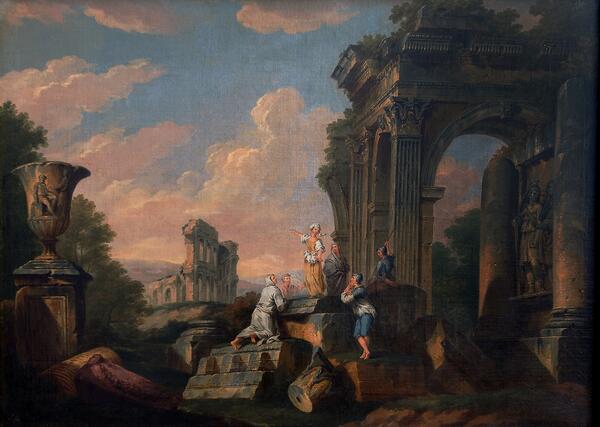“Landscape with Ruins” by Giovanni Paolo Panini, a painter of architectural views and ruins, represents the Roman school in the collection of the Primorye Art Gallery.
In the 17th century, landscape painting stood out as an independent genre. This type of landscape (known as the “landscape of ruins”) started developing with the birth of archaeology: in the second half of the 18th century, the ancient cities of Pompeii and Herculaneum, which had died during the eruption of Vesuvius, were found and partially excavated. Antiquity, discovered under the ashes in such a frozen-in-time, momentary state, struck people of Enlightenment, aroused interest in ancient monuments, and brought to life a new wave of imitation of the classics.
The artist depicted the ruins as the main character and admired their monumental scale and grandeur. Rome was becoming the center of the formation of classicism — a new trend in the art of the second half of the 18th century. In Panini’s “Landscape with Ruins”, the principles of this trend in art are revealed very clearly — a notional composition, which probably features real ruins, abundant in Italy back then.
Giovanni Paolo Panini created his works by the force of his imagination. Such paintings, with their ideal, refined nature and commonplace pictorial patterns, could risk looking void of spirit. Therefore, the artist tried to enliven the static scenery with the so-called “staffage” — human figures in the foreground. Most often, the plots for such scenes were episodes from the life of the Romans. Having prepared a set of sketches of ancient ruins of temples, colonnades, and porticos, the painter of a ruin landscape would generally choose those that fit best his artistic vision, add some vegetation in the background, the sky to match the mood, a group of people in the foreground — and a landscape with ruins was ready.
In the 18th century, such decorative paintings enjoyed enormous success with the owners of villas, palaces, and castles. Giovanni Paolo Panini was quite a successful artist: he worked at the papal court in Rome, and in Paris. In 1719, he became a member of the Academy of St. Luke in Rome and a member of the French Royal Academy in 1732.
In the 17th century, landscape painting stood out as an independent genre. This type of landscape (known as the “landscape of ruins”) started developing with the birth of archaeology: in the second half of the 18th century, the ancient cities of Pompeii and Herculaneum, which had died during the eruption of Vesuvius, were found and partially excavated. Antiquity, discovered under the ashes in such a frozen-in-time, momentary state, struck people of Enlightenment, aroused interest in ancient monuments, and brought to life a new wave of imitation of the classics.
The artist depicted the ruins as the main character and admired their monumental scale and grandeur. Rome was becoming the center of the formation of classicism — a new trend in the art of the second half of the 18th century. In Panini’s “Landscape with Ruins”, the principles of this trend in art are revealed very clearly — a notional composition, which probably features real ruins, abundant in Italy back then.
Giovanni Paolo Panini created his works by the force of his imagination. Such paintings, with their ideal, refined nature and commonplace pictorial patterns, could risk looking void of spirit. Therefore, the artist tried to enliven the static scenery with the so-called “staffage” — human figures in the foreground. Most often, the plots for such scenes were episodes from the life of the Romans. Having prepared a set of sketches of ancient ruins of temples, colonnades, and porticos, the painter of a ruin landscape would generally choose those that fit best his artistic vision, add some vegetation in the background, the sky to match the mood, a group of people in the foreground — and a landscape with ruins was ready.
In the 18th century, such decorative paintings enjoyed enormous success with the owners of villas, palaces, and castles. Giovanni Paolo Panini was quite a successful artist: he worked at the papal court in Rome, and in Paris. In 1719, he became a member of the Academy of St. Luke in Rome and a member of the French Royal Academy in 1732.



